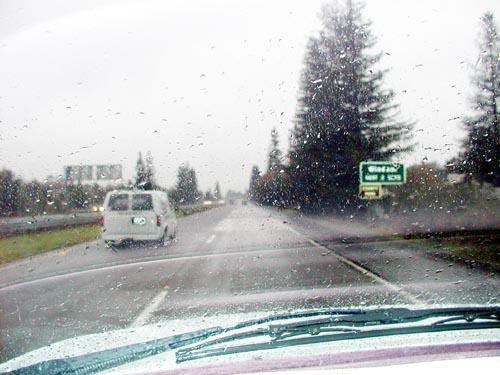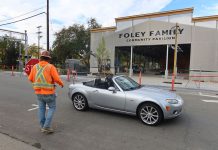As winter weather sets in, bringing rain, sleet, fog and ice to
the roads, local police departments remind drivers to be mindful of
adapting driving habits to inclement weather conditions.
In a press release sent Dec. 5, CHP officer Barbara Upham wrote
a reminder to Sonoma County residents.
“Recently we experienced our first significant rainfall of the
season. Along with the rain, we will experience fog as well as icy
roadway conditions. Driving in adverse weather conditions requires
a different driving attitude,” she wrote.
Because of reduced visibility Windsor traffic officer Bill Focha
said drivers need to keep a longer following distance between
vehicles.
“Increase your following distance by one second, typically you
want to go three seconds, in rain you want to increase that by one
second and if it is dark you want to add another second. That is a
minimum following distance, not a hard and fast rule,” he said.
Upham said people need to drive slower, keep a safe distance
between vehicles and carry an emergency kit in their vehicle.
“The most important thing you can do while driving in adverse
weather conditions of any kind is to reduce your speed, and
increase the distance at which you follow other vehicles,” she
said. “It is also a good idea to carry emergency supplies in your
vehicle. Flares, water, a blanket, first aid kit and fire
extinguisher are among some of the items you should consider
keeping in your vehicle.”
Healdsburg police officer Nick Castaneda said drivers’
visibility is greatly reduced during inclement weather, which
increases the potential for an accident.
“When it is raining you have less visibility and the roadway is
wet and people still drive too close to each other … not being
cautious enough and forget to slow down,” he said. “I’ve only been
here three years but once we start getting the rain, accidents tend
to rise.”
Officers said that overall drivers need to focus on driving
defensively rather than driving fast to get somewhere on time.
Sebastopol traffic officer James Conner said there are six
precautions drivers can take.
“In weather related crashes, there are six things you can do
that would drastically reduce collisions or injuries caused by
collisions,” he said. “Number one, defrost your window first;
number two, always buckle up even for short drives; number three,
reduce your speed to the conditions of the roadway; allow extra
following distance, you should never follow any closer than three
seconds; always monitor the tread on your tires and the break level
fluid in your car.”
Conner also said pedestrians are more likely to be hit on a
rainy day because they may dash out into the street trying to avoid
the rain.
“In particular during inclement weather, watch for pedestrians.
Remember they are in more of a hurry to get out of the bad weather
and they might dart out into the road expecting you to see them and
you don’t because the bad weather reduces your ability to see
them,” he said.
Upham said black ice patches on the road pose a hidden danger
for drivers and keeping a safe following distance helps prevent
unforeseen accidents.
“Safe stopping distances are greater on wet or icy pavement.
Brake and steer gently to avoid causing your vehicle to skid or
hydroplane. Even if the pavement appears dry, it is important to
remember that if it was cold, rainy or foggy the previous night,
black ice might be present,” she said.
An increased number of intoxicated drivers is also a danger
during the winter driving season. Officer Focha said drivers should
be wary of drunk drivers returning from holiday parties and people
should be mindful of their own alcohol consumption.
“Designate your drivers and that type of thing,” he said.
“Everybody’s body is a little different no matter what the
substance is. The chart the DMV gives you with your driver’s
license is pretty much a rough guide on the average person and it
is fairly accurate.”
Officers said it is possible for a driver to be arrested for DUI
even if they are under the legal limit of .08 blood alcohol level.
Officer Conner said drivers need to keep in mind that their body
may not metabolize alcohol as quickly as the average person and
their driving may be impaired more than they think.
“I would particularly like to remind people that during the
holiday party season they need to be extra careful on the roadway
because of increased DUIs and they should be careful of themselves.
The legal limit for blood alcohol content is .08. Even then your
ability to operate a vehicle and avoid a collision are drastically
impaired so I would like to remind people not to drink and drive
and be aware of others who may drink and drive because that
endangers all our safety,” he said.
Upham said that in the event of an accident people should pull
off to the side of the road and get away from traffic as soon as
possible.
“Never stop your car on the freeway or in the middle of the
road. If your vehicle becomes disabled or is hit in a traffic lane,
activate your emergency flashers and move away from your vehicle to
a place of safety,” she said. “Avoid crossing lanes and look for a
barrier such as a guard rail, concrete barrier, or trees. Stand so
that the barrier is between you and traffic and never turn your
back to traffic.”
When an accident has occurred other drivers should allow a
passage for emergency vehicles to respond to the accident said
Windsor Fire Station Captain Ron Busch.
“Give us a lane and what I mean by that is when you see lights
from Caltrans, or CHP or fire department vehicles on the roadway,
give us the lane. Pull to the right, a lot of vehicles will just
stop where they are at and that does not do us any good, we need
them to pull to the right,” he said.
Police said in Windsor most accidents tend to happen at Old
Redwood Highway and the Highway 101 Windsor exit. Sebastopol’s
accident prone areas are on Highways 12 and 116 said Officer Conner
and Healdsburg’s problem areas tend to be downtown said Officer
Castaneda.
“On our major intersections, for example Dry Creek and
Healdsburg Avenue or Dry Creek and Grove Street and Healdsburg and
Mill Street and they are all busy intersections and they have a lot
of cars,” Castaneda said. “Sometimes the light turns yellow and
people want to make the light. People are not being cautious enough
and they need to slow down.”









